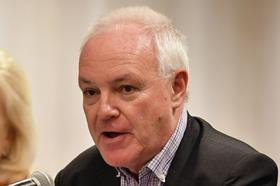The threat of a levy on our profession to cover the reported £64m loss of client money by Axiom Ince Ltd has aroused consternation and comment in public and private forums. At around £400 per head, something must be done – but what? Relatively few facts are in the public domain, but I will attempt to identify some which merit consideration.

Some claim these events are a consequence of allowing alternative business structures. Axiom Ince was not an ABS, though it had acquired the practices of two ABSs, Ince Gordon Dadds LLP and Plexus Legal LLP (each with a history of two insolvencies), in April and July 2023 respectively. No members of either practice became members of Axiom Ince, so no Solicitors Regulation Authority approval was required despite the firm’s massive expansion: its accounts for the year ended 31 March 2022 reported that the average number of employees was 98, but by 2023 I understand there were about 1,400.
SRA chief executive Paul Philip was reported in the 27 September Gazette as saying: ‘There appears to be growing confidence we have done everything we should have done according to our regulatory arrangements.’ Some may consider that justified but, as the Russian proverb says, ‘trust but verify’. Given the amounts involved, the public and the profession need reassurance.
The statement raises three issues. First, what did the SRA know and when? One commentator claims to have reported concerns about the firm’s client account to the SRA in November 2022.
Second, we know that the SRA follows media reports on firms, and an SRA Board Report as long ago as 1 October 2018 stated that ‘[our] existing approach to risk rating firms for [anti-money laundering] (AML) uses an artificial intelligence model, and the risk we have asked the model to identify is the risk that a firm will have an AML-related issue reported to us’. Did these means of monitoring the profession fail? Does an increase in staff size of over 1,300% in a year not merit a regulatory inspection for a firm doing work in the regulated sector for AML purposes?
Third, if the SRA did do everything required under its rules, it is the SRA which makes the rules (subject to approval by the Legal Services Board). Are the rules fit for purpose?
Who pays? Some have commented in blogs that insurers will pay. However, in my experience from advising on a large number of ‘rogue partner’ and similar cases, many coverage issues will arise. All policies contain an aggregation clause, under which multiple claims are subject to one policy limit, and we do not know what excess layer cover the firm had or its terms (if indeed it had any). The Court of Appeal decision in Baines v Dixon Coles & Gill [2021] EWCA Civ 1211 (nearly six years after the SRA intervention) held that multiple policy limits applied, but may not be determinative in this case if there were a few large withdrawals of client money.
Given the substantial sums in client account and the firm’s size before its acquisitions, there may (perhaps) be questions over whether all the money was held in the course of practice or whether any was held merely as a banking facility, giving rise to further complications.
All policies exclude cover for fraud or dishonesty, but under clause 6.8 of the SRA Minimum Terms and Conditions (which only apply to the £3m primary cover) ‘the insurance must provide that no dishonesty, act or omission will be imputed to a body corporate unless it was committed or condoned by, in the case of a company, all directors of that company’. There were 18 directors at various times between 2022 and 2023.
The SRA is considering a levy on solicitors for the Compensation Fund on the basis that the reputation of the profession may be at stake. It is a discretionary fund with, in general, a £2m limit per claimant. Eligible claimants are restricted with various £2m limits on incomes or assets.
There is also a £5m cap in the case of multiple applications relating to the same or connected underlying circumstances. The SRA’s application in 2021 for LSB approval of the cap estimated that multiple claims at the time ranged from £1m to £10m with an average of £5m. The LSB accepted that the £5m limit was proportionate. If that is now to be overridden, we need Wednesbury-compliant reasons. The Institute of Chartered Accountants in England and Wales’ probate scheme has a limit of £5m per year; Financial Services Compensation Scheme claims for deposits are limited to £85,000 per claim.
The Compensation Fund has always been intended as a fund of last resort. Even in 1960, the Guide to the Professional Conduct and Etiquette of Solicitors by Sir Thomas Lund stated that applicants would usually be required to institute bankruptcy proceedings against the solicitor and prove in the bankruptcy, so the profession should not be the first port of call for the full amount.
What next? With the profession potentially facing an enormous cost (and who knows, maybe not for the last time), against a background of concern about what the SRA knew and when, and what it did in consequence, there is a clarion call for some oversight about how it now responds, a role the Law Society may be unable to fulfil.
An inquiry is premature against the background of possible criminal and disciplinary investigations. Whether firms should continue to hold client money, and the roles of the reporting accountants, and of administrators and solicitor managers in pre-pack sales, may also have to wait for another day.
However, the profession could gain some confidence if the SRA’s actions to date and its response were subject to oversight by a retired High Court judge and a solicitor with recent experience of SRA regulation – perhaps a recently retired law firm general counsel.
Frank Maher is a partner at Legal Risk LLP, Liverpool





























2 Readers' comments